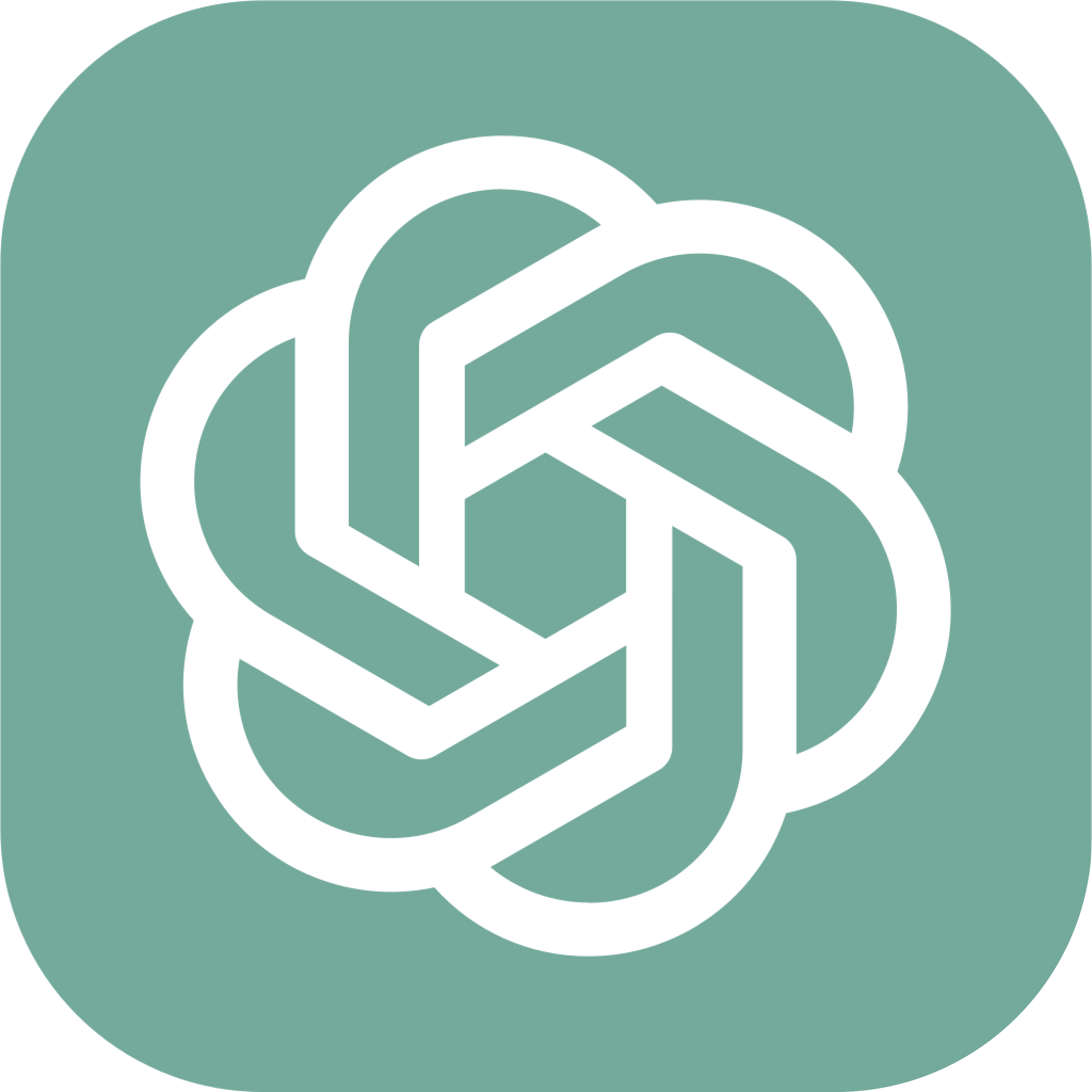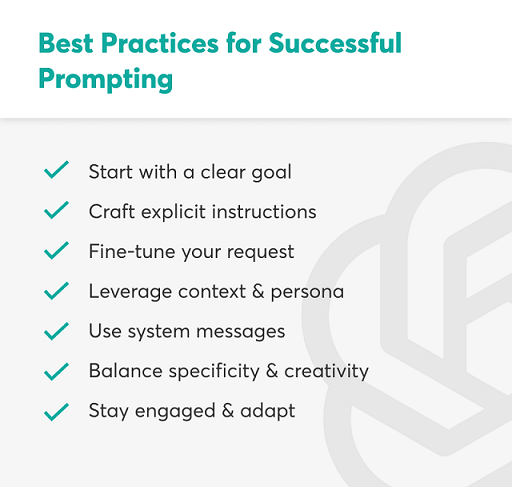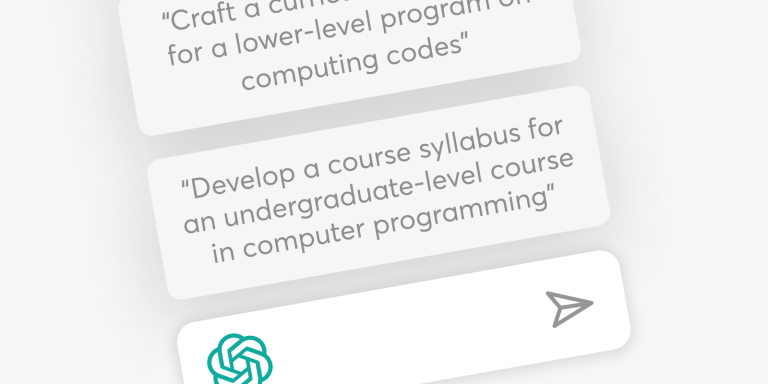Table of Contents
Have you ever wished for a virtual assistant that could understand and respond to your queries just like a human? Well, your wish has come true with ChatGPT!
ChatGPT is an incredible breakthrough in the field of artificial intelligence, designed to engage in dynamic and interactive conversations with users like you.
It’s like having a knowledgeable companion at your fingertips, ready to assist you in a wide range of topics.
In this article, we’ll explore the power of ChatGPT and how you can harness its capabilities to revolutionize the way you create your online courses.
We’ll guide you through analyzing instructional problems, setting objectives and goals, and building a comprehensive course outline.
Get ready to embark on a transformative journey that empowers you to create online courses like never before. Let’s dive in and unlock the full potential of ChatGPT!
Table of contents
Prompting: The Art of Prompt Engineering
When interacting with ChatGPT, the key to initiating a conversation is through prompts.
Still wondering what a prompt is? A prompt is a starting point or an instruction given to ChatGPT, which sets the context for the conversation.
Think of prompts as the secret sauce that helps ChatGPT understand what you’re looking for and respond accordingly.
The beauty of prompts lies in their flexibility – you can shape them to suit your specific needs and elicit the desired information or assistance.
Now, to truly unlock the potential of ChatGPT, mastering the art of prompt engineering is essential.
Crafting effective prompts involves striking the right balance between clarity and specificity. You want to provide enough context to guide ChatGPT, but not overwhelm it with unnecessary details.
💡 To illustrate the power of prompting, let’s see an example:

You are a course creator. You have identified that your target audience consists of busy professionals who struggle to balance their work and personal lives. What are some best practices for designing an effective course on time management to help your students apply what they learn to their daily lives?
With this prompt, ChatGPT can generate valuable insights and suggestions for creating an impactful course on time management.
It can recommend strategies such as creating engaging slides with key takeaways, providing detailed speaker notes, incorporating visuals, including quotes from experts, highlighting statistics and data points, and sharing engaging anecdotes or case studies.
These recommendations can help you sound like a seasoned pro in your course creation endeavors.
💁 Check out the following video to learn more about prompt engineering:
How Can You Achieve Successful Prompting?
Unlocking the true magic of successful prompting begins with a set of invaluable best practices. Embrace them and witness your conversations with ChatGPT soar to new heights.
Start with a clear goal
When delving into the realm of ChatGPT, it’s essential to begin with a crystal-clear objective in mind. Take a moment to define the specific outcome or information you’re seeking.
Whether it’s writing a captivating story, solving a complex problem, or simply engaging in a stimulating conversation, having a well-defined goal will serve as your guiding light throughout the interaction.
Craft explicit instructions
To harness the full potential of ChatGPT, it’s crucial to provide explicit instructions. When you require specific actions or answers, ensure your prompt includes clear directives.
By leaving no room for ambiguity, you’ll steer ChatGPT toward delivering the precise results you’re looking for.
This clarity not only enhances the efficiency of the conversation but also minimizes any potential confusion.
Embrace the power of iteration
Rome wasn’t built in a day, and the same holds true for mastering the art of prompting. If you find yourself unsatisfied with the initial responses, don’t be disheartened.
Instead, embrace the power of iteration. Refine your prompts, experiment with different phrasings, and explore alternative approaches.
By persistently fine-tuning the conversation with ChatGPT, you’ll uncover its vast capabilities and unlock the desired outcome.
Leverage context and persona
ChatGPT performs best when provided with relevant context and a well-defined persona.
Incorporate relevant details into your prompts to set the stage and guide the model’s responses.
Whether it’s a specific scenario, historical context, or a particular tone, infusing your prompts with contextual cues will enable ChatGPT to provide more accurate and tailored responses.
Harness the flexibility of system messages
System messages are like little notes that you give to ChatGPT to guide the conversation and make it more fun or helpful and shape the behavior of ChatGPT.
System messages help you and ChatGPT communicate better and have a great conversation together!
Imagine you have a talking robot friend named ChatGPT. When you talk to ChatGPT, you can give it special messages called “system messages.” These messages are like instructions or hints that help ChatGPT understand what you want to talk about or how you want it to respond.

For example, if you want to play a game with ChatGPT, you can start with a system message that says, “Let’s play a game!” This helps ChatGPT understand that it should respond in a playful way and be ready to play with you.
Strategically inserting system messages at appropriate intervals can help set the conversation’s tone, provide additional context, or even nudge ChatGPT toward desired behaviors.
Experiment with using system messages to guide the conversation in a way that aligns with your objectives.
Balance specificity and creativity
While explicit instructions are valuable, it’s also essential to strike a balance between specificity and creativity.
Allowing some room for ChatGPT’s imagination can lead to surprising and innovative responses.
Encourage creative thinking by providing high-level guidance while leaving space for ChatGPT’s unique perspectives and ideas to shine through.
Stay engaged and adapt
As you interact with ChatGPT, maintain an active role in the conversation. Stay engaged, monitor the responses, and adapt your prompts based on the model’s feedback.
Being responsive to ChatGPT’s answers will help you build a dynamic and collaborative dialogue, enhancing the overall quality of the interaction.

Analyze the Instructional Problem
Every great journey begins with understanding the destination. In the world of learning, it’s essential to analyze the instructional problem before embarking on the quest to create effective and engaging learning experiences.
By unraveling the intricacies of the problem, you can shape a solution that perfectly fits the needs of your learners, right? So, understanding your audience, their training needs, and the topic is essential.
Learn about your learners
By asking targeted questions to ChatGPT, you can gain insights into your learners’ characteristics, their background, and existing misconceptions, and even find related courses to understand their content and approach.
Start your ChatGPT conversation with prompts that will help you learn more about your learners.
Here’s a nice and clear example of a ChatGPT prompt that you can use to discover your learners’ learning characteristics:

Act as an instructional designer who creates a course to help [audience] learn about [topic]. What are the learning characteristics of this audience as they relate to [topic]?
Here’s another example of a ChatGPT prompt that you can use to create your learner personas

Create [X] personas for [audience] who want to start learning for [topic]
In this case, the [audience] could be “business leaders” and the [topic] could be to “improve their public speaking skills”
Identify your learner’s training needs
As soon as you have all the information you need about your learners, you can leverage ChatGPT to unveil the training needs these learners may have. A very effective way to do this is to ask ChatGPT to give you insights about your learners’ backgrounds.
Here’s an example of asking ChatGPT to identify the training needs of your learners:

What experiences do [audience] have in relation to [topic]?
In this case, the [audience] could be “young adults” and the [topic] could be to “manage their budget”
You can even use ChatGPT to identify and address the misconceptions your learners may hold about the topic at hand. By shining a light on these misunderstandings, you can pave the way for clarity and deep comprehension.
Here’s a specific example of a ChatGPT prompt to identify your learners’ misconceptions about a topic:

Which are the misconceptions of [my audience] for [my topic]
In this case, the [audience] could be “beginners” and the [topic] could be “project management”
Get more information about your topic
Now that you have most of the information on the instructional problem at hand, you are ready to get more information about the topic you are planning to teach.
Here’s an example of a specific prompt you can use to ask for existing related courses with short summaries:

Propose a comprehensive list of online courses designed for [audience] and [topic] each with three key points describing their contents
In this case, the [audience] could be “beginners” and the [topic] could be “Social Media Strategy”
You can take it a step further, and even ask for a curriculum for your topic at hand:

Create a curriculum for beginners in Social Media Strategy
As you can see until now, with each step that you take in analyzing the instructional problem at hand, you bring clarity to it and you set the stage for crafting an exceptional learning experience, where curiosity thrives, misconceptions dissipate, and the transformative power of education takes flight!
Setting Objectives & Goals
Learning goals serve as broad and general statements that outline what students are expected to learn, offering direction, focus, and cohesion to the learning experience. By setting clear goals, both instructors and learners gain a roadmap that guides them toward their desired destination.
Learning objectives, on the other hand, are specific and measurable subgoals that provide clarity to the overall goals. They help instructors stay focused and aid in planning by using action verbs to describe the capabilities learners should possess upon completing the course.
From the learners’ perspective, objectives help them understand what is expected of them and what they can expect from themselves throughout their educational journey.
As you realize, learning objectives play a crucial role in effective instruction for both instructors and learners.
You can use diverse approaches and methods to generate clear and measurable learning objectives, such as Reigeluth’s simplified conditions method, the SMART approach, or Bloom’s taxonomy.
By asking ChatGPT to help you create learning objectives, you can ensure that your course aligns with your desired outcomes.
So, let’s see a few examples of how you can ask ChatGPT to generate your learning objectives using these methods and approaches:
Here’s an example of asking ChatGPT to identify the most fundamental concepts or skills for your course using Reigeluth’s simplified condition method:

Use Reigeluth’s simplified conditions method to create six learning objectives for my course. I am creating a course to teach [my audience] [my topic]
In this case, the [audience] could be “families” and the [topic] could be “how to manage their budget”
Here’s how you can ask ChatGPT to generate a set of objectives for your topic using Bloom’s taxonomy:

I am teaching a course to help [your audience and topic]. Give me 5 learning objectives using Bloom’s taxonomy.
In this case, the [audience] could be “Dog owners” and the [topic] could be “to train their dogs to do fun tricks”
Building the Course Outline
Now that you have a clear understanding of your instructional problem and learning objectives, it’s time to build your course outline.
There are various instructional approaches you can utilize, such as Merrill’s principles of instruction, Gagne’s nine events of instruction, Kolb’s experiential learning theory, or a problem-based learning approach.
By applying these principles and asking ChatGPT for assistance, you can create a well-structured and engaging course outline that caters to your learners’ needs.
Now, let’s explore some captivating examples of prompts that incorporate the theories we discussed earlier.
These prompts are ready to be directly input into ChatGPT, allowing you to witness its remarkable capabilities:
Take a moment to try these prompts yourself, using the same topic for each. You’ll be amazed by the prowess of ChatGPT as it responds to clear and concise instructions, showcasing the beauty of its capabilities.
Building Learning Content
Once you’ve crafted your course outline, it’s time to breathe life into your content and captivate your learners. With ChatGPT’s exceptional abilities, the possibilities are endless!
Let’s explore how ChatGPT can assist you in building compelling and engaging learning content that will leave a lasting impact.
Imagine having the ability to generate text or video scripts effortlessly. ChatGPT can do just that, ensuring you have content that educates, entertains, persuades, or informs your audience.
Not only that, but you can also optimize your existing texts, transforming them into polished pieces that resonate with your learners.
But that’s not all! ChatGPT can simplify complex concepts, making them more accessible to your students. It can even compare different concepts, helping learners grasp their similarities and differences effectively.
Engage your audience with the power of storytelling, as ChatGPT presents your content in a captivating narrative format.
Inject a sense of curiosity by creating contra-content and injecting doubts, prompting critical thinking among your learners.
Foster interaction with Q&A sessions, flashcards, or even content for your presentation slides.
Embrace fun and creative approaches, using emojis and the emojis translator to add a touch of playfulness to your content.
Expand your toolkit further by creating crossword puzzles, role-play scenarios, timelines, journal prompts, annotated bibliographies, concept maps, infographics, glossaries, and storyboards.
These diverse content types will bring variety and depth to your course, ensuring a rich and engaging learning experience.
💡 Excited to dive into real-life examples of all these content types?
Watch now our free, on-demand workshop “Master ChatGPT for Course Creation with the Art of Prompting,” where we delve into each one with meticulous detail.
You’ll discover expertly crafted prompts for ChatGPT, tailored to online course creation. Let your creativity soar and watch your course content come to life with ChatGPT as your guiding companion.
Building Creative Assessments
An online course is clearly not completed as soon as you have the content in place, right? You have to make sure your learners truly understand what you’ve taught them by creating interesting assessments.
The main purpose of assessments is to help you see if your course was effective and if your learners comprehend what you wanted to teach them.
You can create unique and engaging content for your online courses, as well as different types of assessments, by using various methods.
But don’t stop there! There are many other creative assessment methods you can explore.
You can use interactive quizzes, projects with pictures and videos, group discussions, portfolios, and tasks that let learners show their skills in real-life situations.
By using different assessment methods, you can accommodate different learning styles and give learners a chance to show what they’ve learned in ways that work best for them.
Remember, assessments are not just about checking how well learners performed or granting them a certification. Assessments are also a chance for your learners to grow and reinforce what they’ve learned.
By using engaging assessments, you create a fun learning environment where learners can show what they know and feel proud of their achievements.
With an all-in-one learning management system like LearnWorlds, you can easily input the content and types of assessments for your learners, thanks to its powerful Assessment Builder tool.
💁 Discover more about LearnWorlds powerful Assessment Builder here
✨ Supercharge Your Course Creation with AI!
Want to create exceptional learning experiences faster and smarter? Discover how you can harness the power of AI in instructional design. Watch our on-demand webinar to learn tips, tricks, and best practices from industry experts.
Ready to Revolutionize the Way You Create Online Courses?
Prompts are the key to unleashing the full potential of ChatGPT. They set the context, guide the conversation, and enable ChatGPT to understand and respond to your needs with astonishing accuracy.
Crafting effective prompts requires a delicate balance of clarity and specificity, allowing you to shape the conversation and elicit the information you seek.
Imagine creating an impactful course on time management for busy professionals. By using the power of prompting, you can ask ChatGPT for best practices, strategies, and expert insights tailored to your audience’s needs.
The recommendations you receive will transform your course creation endeavors and position you as a seasoned pro.
But successful prompting goes beyond clarity and specificity. It requires a set of best practices that will take your conversations with ChatGPT to new heights.
Start with a clear goal in mind, provide explicit instructions, embrace iteration, leverage context and persona, harness the flexibility of system messages, balance specificity and creativity, and stay engaged and adapt throughout the interaction.
These practices will empower you to navigate the world of ChatGPT with ease.
Now, you may be wondering how to apply these techniques to your own course creation process. That’s where our free online workshop, “Master ChatGPT for Course Creation with the Art of Prompting,” comes in.
In this workshop, we dive deep into the intricacies of prompting and provide you with expertly crafted prompts specifically tailored to online course creation.
You’ll witness firsthand how ChatGPT can generate diverse content types, optimize existing texts, simplify complex concepts, and engage your audience with storytelling and critical thinking prompts.
Don’t miss out on this incredible opportunity to enhance your course creation skills. Join us for the workshop and embark on a journey of discovery, where the power of conversational AI meets the art of prompting.
Let ChatGPT be your trusted companion as you create courses that captivate, educate, and inspire learners around the world.
Rosemary is LearnWorlds’ Content Marketing Manager. She has over 2 decades of experience in omnichannel marketing and content writing for the IT and SaaS industry. Her expertise lies in crafting effective content marketing strategies that attract, engage, and nurture customers, enabling LearnWorlds to reach its target audiences with precision.



